
Visco Games, 2001
If you were to make a shmup that borrowed several elements from other, better-known ones, and still manage to make a unique and enjoyable game, the Vasaras by Visco show you how to do it.
There. Now that I've said it, I can review in a more leisurely manner.
Shmups have often been an explicitly futuristic genre; at one point, they were called 'space games'. The next most common style is the militaristic shmups, which may or may not be futuristic (in my opinion, we need more WWII shmups without P-38s, Shindens or P-47s (and more World War II movies set in the Burma and New Guinea campaigns, but I digress)), fantasy (as much Moorcock as Howard as Tolkien) shmups, with an indeterminate 'medieval' setting and the odd steampunk shmup. More explicit historical settings are rare (if not existant) in shmups, at least. The closest thing so far was the Sengoku Aces (set in an indeterminate 'feudal' Japan era) series and Robo Aleste (which more than dabbled in a historical setting as well). Then came Vasara, released in 2000 by Visco.
Visco were best known for entertaining but unremarkable, 'me-too' shmups like Ashura Blaster, Andro Dunos and Storm Blade (Captain Tomaday is another cup of tea). Vasara was far superior to their previous games, and holds its own against the Sengoku Ace shmups. Done in 'Sengoku-steampunk' style, it featured a charge melee attack (most of Visco's games are fond of charge shots) and a simple but fairly intuitive chaining system. Since the game is already reviewed elsewhere, I will merely direct you to the review pages of shmups.com and get back to its sequel.
Vasara was released in 2000 by Visco (who've been making games since the nineties), and was set in Sengoku-era Japan (if you don’t know what that is, look it up). So: there were several clans vying for de facto control of Japan (in spite of there still being an emperor): in the end it was the Tokugawa clan which won out and ruled Japan for, like, 200 years. In the game, you, the player, played one of three players who had a grudge against Tokugawa Ieyasu, the Shogun, and set out to kill him. What made the game more fun was that you played against (and even as) historical characters of the era.
Vasara 2 was released in 2001, which either means that the original was popular enough to warrant a sequel or Visco were just going the Hollywood way. Whatever it was, it is good enough to warrant the rating I give it, and the rest of the review will attempt to convince you that it is indeed worthy of my rating.
The villain of this game is Oda Nobunaga. The most powerful feudal lord of Japan at the time of his death; a great innovator in military tactics of the time. More to the point, he rubbed all the player characters (or their families/clans) up the wrong way. In real life, this (supposedly) resulted in the historical "Incident at the Honnoji"*, which led to his real-life demise*. As befits a quasi-historical shmup set in feudal Japan, you are allowed to play as one of five (one is hidden) characters who had issues with Nobunaga, flying on hoverbikes. These are:

Akechi Mistuhide: The 'betrayer of Nobunaga'*, previously a retainer of the same*. As befits a samurai, he wields a katana.
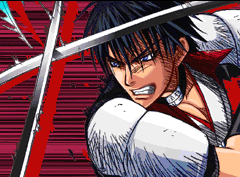
Takeda Nobukatsu: Son of the head of the Takeda clan*, which Nobunaga crushed a few years back. I suppose he wants his own back. As also befits a samurai (albeit a pretty boy one), he wields a katana too.
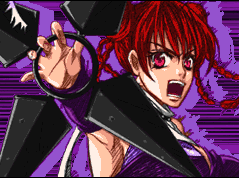
Momochi Sandayu: Of the Iga clan (a ninja one), whom Nobunaga had issues with. She handles shurikens and some kind of oversize shuriken for hand-to-hand combat. It is later revealed that she and Mitsuhide were together in some kind of plot.
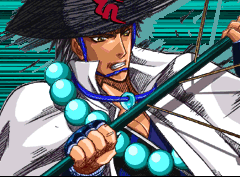
Seriyubo Zuifu: A warrior-monk type of guy (wonder if he knows Tengai). Guess Oda Nobunaga had issues with the sect he belonged to*. Wields a staff, and has green eyes, too! Definitely a badass-in-training. Revealed to be Mitsuhide’s stepson.
You can also play as 'Saika Magoichi', from the first Vasara, though the character has changed sex and age. His vehicle and attacks, however, are the same.
During the game, you fight against the armies of Nobunaga and his other retainers and allies as you rush to kill him. I will not list them out, and since the game kindly gives you their names in English as well, you can find out more about them if you wish on Wikipedia. Some effort has been spent in trying to have a historically accurate 'cast' of said allies as your enemies. I found the use of an explicitly historical setting highly entertaining. Robo Aleste had already attempted it, but this is a much more satisfying attempt at pseudo-historicity. They should do this more often, preferably in a non-Japanese historical setting. How about a shmup at the Battle of Bosworth? Coming to think of it, one could have made a fairly accurate shmup of 300 in this style. Or even the battle in the Anglo-Zulu Wars Zulu was based on.
GAMEPLAY/SCORING/BLAH
The essential gameplay is the same as Vasara, with two crucial differences. You are equipped with two shots: the usual straight shot fired by tapping the shot button/button 1, and a slash/melée attack activated by holding down the shot button. Now the charge shot lasts for a short while, and can kill several enemies at one time (eight or nine is my personal record). The attack also reflects enemy bullets and these can do damage. The range, power and speed of charging vary from character to character. Sandayu charges the fastest and her attack has the widest range. Seriyubo's has the longest range, but its spread and time to charge suck. The other two have generick katana slashes, though Mitsuhide’s attack packs a stronger punch. The enemies also use slash and spear attacks, often using them to push you into their bullet patterns. A small tip: everyone is right-handed here.
Hitting an enemy also releases several blue gems, which fills up three small gauges. These are the 'Vasara' attacks of the predecessor, replacing smart bombs. Pressing button 2 unleashes a melée attack on steroids, allowing you to do much more damage for a longer time too. This empties out a gauge and needs to be filled again before use. The normal shot is powered up by the usual 'P' icons, which are released by the yellow and red six-legged hoverbikes (you'll know them when you see them). You are expected, however, to ignore the regular shot and hack away with your charge shot. I suppose there is something highly satisfying to the human unconscious about physically attacking an enemy.
Now, while slashing away merrily may seem a way to impair the difficulty and challenge of the game (since you can reflect bullets), blind slashing can be foolish (especially halfway through stage 3). And keep in mind that any kind of shot that is purple cannot be dodged. Some bullet patterns fired by the bosses and sub-bosses can only be managed on the principle that they can be reflected. Smells of Giga Wing, eh? Slashes have to be timed to move the most bullets out of the way and kill/damage as many enemies as possible. The latter also has some implications for the chaining system Vasara 2 employs. Bearing that in mind, Sandayu’s attack is a good choice to go for large-range, multiple kills with the slash. Perfecting the slash attacks’ timing is essential to survive several boss and enemy attacks- do it badly, and you will get hurt in the time between charging, or reflect the wrong attack.
Scoring is three-tiered: straightforward kills and gold bricks, 'prestige' kills (to borrow an apt term from another reviewer) and your chain. Taking a leaf out of Psikyo's (and therefore, V-System's) book, some enemies drop gold bricks which give either 500 or 2000 points (less sadistic than Psikyo, then) depending on how much they shine at the time of picking up. There are also double piles of gold worth 5000 or 10000. Then, in a nod to V-System, power-up items, once one is fully powered-up, give you either 1000 or 4000 points! The prestige kills consist of killing enemies bearing a banner or speaking to you,these being either vanilla enemies or full-blown sub-bosses (there being four of them per stage). Killing the boss gives you the last prestige kill. There are 25 per stage, and collecting all of them gives you a hefty 150,000 points, as much as a whole stage in the previous game could!
And so, on to the chain. In the previous game, killing n enemies with your charge attack at one blow gave you 500n points. Here, it's not a question of killing as many enemies with one charge shot. Once you kill more than three enemies with your chain shot (and not necessarily at one shot), you then get a bonus of 100n points for every enemy you kill with your charge shot. Therefore, killing enemy #100 will give you bonus of 10,000 plus its value if it had been shot down. This goes on as long as every charge shot you unleash following the chain start causes some sort of damage to an enemy. The chain does not stop if you break it by shooting down enemies. Hmm… a bit lazy. Some variety to this is added in later stages (especially at bosses) where you must give up your chain to reflect off particularly hairy attacks. Nonetheless, if you are serious about scoring it big in this game, you will soon realise that the best way to do this is to destroy every enemy possible with the charge attack, or the Vasara attack. This can be tedious, but given the fact that slashing down an enemy is so much more satisfying than shooting him down, it may be overlooked.
Did I mention that, like its predecessor, Vasara 2 doesn't kill you if you fly into enemies? Some enemies and bosses like to rush you and push you into the line of their attacks. This goes pretty well with the small hitboxes your characters have.
GRAPHICS
When a game is set in a setting that hasn't had the time to lapse into genericity (i.e. not space or military), design is very important to grab one's eye and to help in maintaining interest. Vasara 2 is certainly no slouch graphically. The backgrounds are a step up from the more digitised ones of its predecessor, with the designers paying more attention to detail. There are a few nice graphical touches, such as military banners slightly moving in the breeze...what? It was there in Vasara? Sorry.
The enemies, sub-bosses and bosses are done in the same entertaining Sengoku-steampunk style as the original Vasara, closer to the Samurai 7 anime than Sengoku Aces/Blade (the apogee of this style). Mecha wielding medieval weapons, tanks with samurai-helmet turrets, armoured bunkers with Japanese heraldic crests and a profusion of skull-decorated enemies are your foes in this game. As in Vasara, a lot of the graphics here are pre-rendered, but it's not much of an eyesore (it gets really bad only for rocky backgrounds). There are some pretty good boss transformations and animations: the bosses of stages 3-5 have pretty good multiple forms, with stage 5's boss flying around like a luchador (since World War II hasn't yet taken place, I can't call it puroresu-yet). There are adequate amounts of blood for all the slash attacks you use on enemies as they die; sadly, there's no cool enemy-falling-into-two-pieces you'd see in Cybattler or in Samurai 7.
A lot of enemies are recycled; in fact, a lot of the characters you run into (including one of your ex-player characters) come from Vasara. This makes sense, as both games are set in the same quasi-historical continuum. All of the ‘prestige’ mecha have their own pilots, several of which were encountered in Vasara. They are drawn in a slightly different from the above, but still have the same vague asymmetry about them. Others are quite memorably designed- a Goth chick (or pretty boy), the manic Hadeshi Hideyoshi (later Toyotomi, who looks vaguely like Chris Cornell), the outrageously-attired (and frankly, rather gay-looking) Maeda Toshiie, a gangsta (I kid you not), several scarred samurai who could’ve walked out of period dramas, (predictably) a ninja and a creepy fellow with his mouth sown shut. In an amusing touch carried over from Vasara, several of them have piercings. Their dialogue (endearingly sub-titled in English) is often the lines of “Come get some/Dilly, dilly, come and be killed/je vais te coller une paire de baffes(sic)”, with some hilarious exceptions. Here are a few:
"If you insistently disobey me, you will receive the sharp point of my spear ?” (eh?)
“Oh, how I love a strong man ? Come on, come over here!” (this is irrespective of the sex of your character)
“Don’t hold it against me, OK?” (said the actress to the bishop)
"I am sorry I cannot allow you to live make you stay alive."
“If only I can defeat you here! Here I go!!” (not with a taunt like that, you won't.)
SOUNDS AND MUSIC
The music is not terrible, but unexceptional. It recycles most of the previous game’s music (itself not the greatest on earth), with a few original tunes done in a Japanese-instrumentaion-plus-modern-music style, the same used in Vasara. The game would have certainly benefited from some more booming Japanese percussion or some fancy shamisen crescendos. Some of the boss music is cooler than its predecessor's, though. The sound effects are roughly above average, the unexciting explosion and shot sounds being offset by the voice clips of the enemies and the various cries emitted by them (and you) when killed. Even without sub-titles, the tone of the sound clips makes it quite clear that the people you fight are not to be trifled with, and will only be satisfied with your death. This certainly is a shmup with hair on its chest, make no mistake about it. There are other nice touches, like the 'tching!' of your charged weapon and the scrapes when you bump into enemies. Well, why kid myself? I can't think of anything else to say about this game's sound.
CONCLUSION
While not really a quantum leap from its predecessor, Vasara 2 is a sufficiently original, solid and worthwhile sequel to Vasara. Its look and feel are very attractive, the gameplay sufficiently intuitive to encourage players to 'get' and (hopefully) master it, and its difficulty curve is sufficiently smooth (though not really linear) to not put players off. I strongly recommend it to all shmuppers, and especially to those who enjoyed the Sengoku Aces aesthetic.
FINAL SCORE: 9/10
*=historical fact

Halfway into Stage 1, and things get busy fast.This is prestige kill #3 so far.
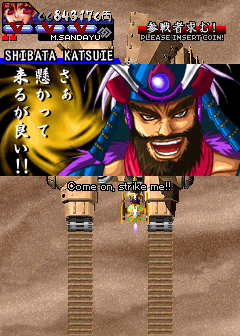
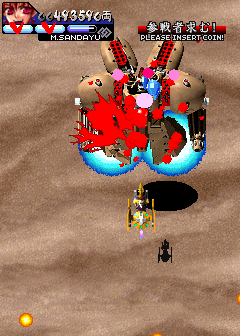
Yes, he really says that.And what Katsuie wants, Katsuie gets.

I don't want to change the world/I don't want the world to change me...
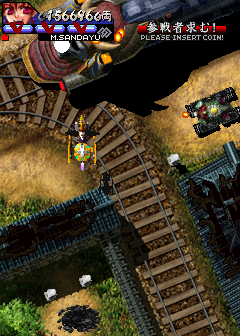
Slightly tricky prestige kill here.

It's not obvious, but this is the gangsta I was promising you. Note the blackletter Y.



Missing from the speech:"Without the Nobunaga clan....". You can really milk this guy's attacks to crank up your multiplier. My personal best: 150.
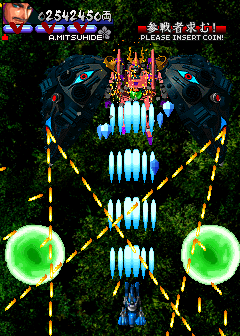
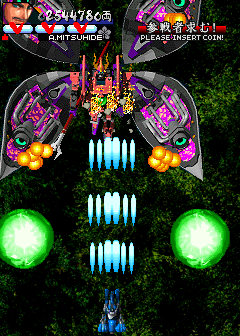
The boss, Maeda Toshiie. His initial attacks can trap you quite quickly if you don't pay attention. And there's always the sharp point of his spear♥...his second form is hardly more difficult, but is much better to look at.

Yeah, whatever...
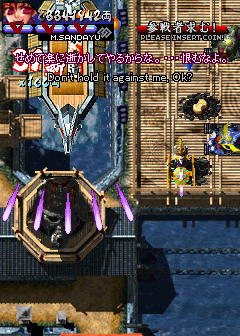
Recognise the boss from Vasara there?
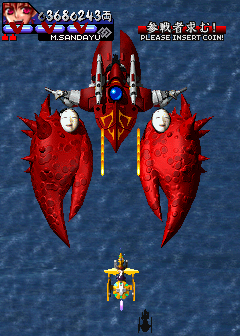
WARNING: A HEAVY BATTLESHIP TAKIGAWA KAZIMASU IS APPROACHING FAST
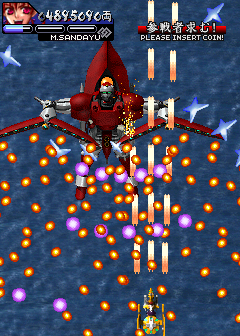
This is where I normally start to die.
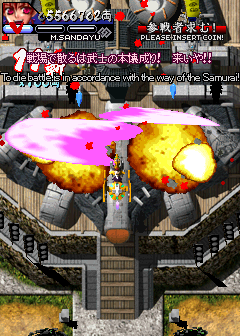
Phooey! I'm a ninja girl!
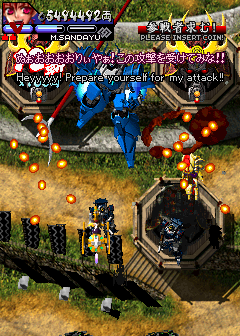
If you say so.
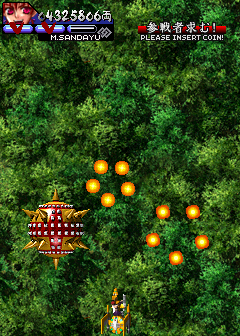
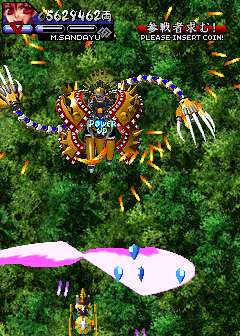
The boss of Stage 5, Hashiba Hideyoshi. Really frisky S.O.B. here.
And so, to end things on a fitting note:
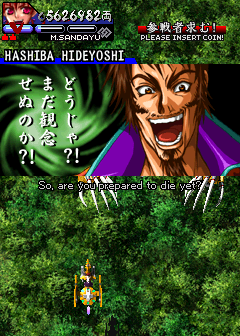
Cheerful fellow, isn't he?
LINKS OF INTEREST
Visco Games' official Vasara 2 site, with lots to interest the fan and the merely curious. Includes character artwork (and brief biographies? maybe), stage layouts and wallpaper.